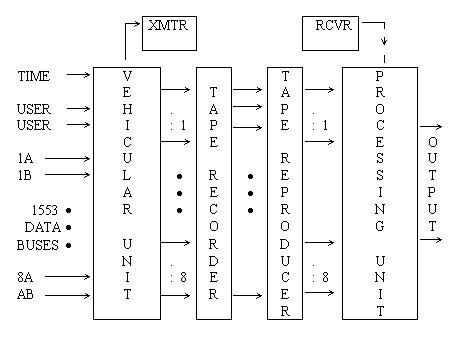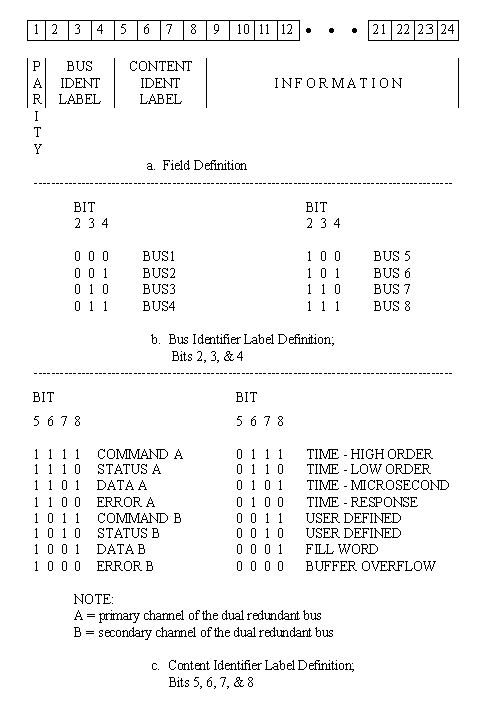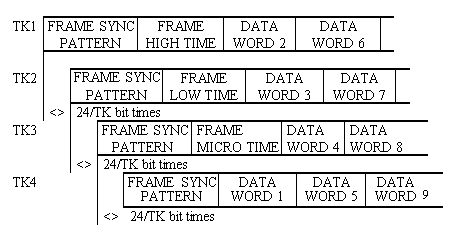|
IRIG 106-99 CHAPTER 8 - MIL-STD-1553 ACQUISITION FORMATTING STANDARD 8.1 General 8.2 Definitions 8.3 Source Signal 8.4 Word Structure 8.5 Time Words 8.6 Composite Output 8.7 Single Bus Track Spread Recording Format MIL-STD-1553 ACQUISITION FORMATTING STANDARD 8.1 General This standard addresses the acquisition of all the traffic flowing on MIL-STD-1553 type data buses. The formats described permit up to eight data buses within a single system. Other constraints such as RF bandwidth and tape recording time will dictate the actual number of buses processed by a single system. Standards for both composite (telemetry) and tape recorder formats are presented. Although specifically designed to satisfy the requirements of 100 percent MIL-STD-1553 bus acquisition, the formatting provisions of this standard may be used in other applications when the data source and content are similar enough to permit easy adaptation. Users should contact the appropriate range to ensure any adaptations are compatible with that range. 8.2 Definitions 8.2.1 Bus Monitor 8.2.2 Data Bus 8.2.3 Dual Redundant Data Bus 8.2.4 Bus Loading 8.2.5 Maximum Burst Length 8.2.6 Bus Error 8.2.1 Bus Monitor. The terminal assigned the task of receiving bus traffic and extracting all information to be used at a later time. 8.2.2 Data Bus. All hardware including twisted shielded pair cables, isolation resistors, and transformers required to provide a single data path between the bus controller and all the associated remote terminals. 8.2.3 Dual Redundant Data Bus . The use of two data buses to provide multiple paths between the subsystems. 8.2.4 Bus Loading. The percentage of time the data bus is active. 8.2.5 Maximum Burst Length. The maximum length of a continuous burst of messages with minimum length message gaps. 8.2.6 Bus Error. Conditions detected which violate the definition of MIL-STD-1553 word structure. Conditions such as synchronization, Manchester, parity, noncontiguous data word, and bit count/word errors are all considered word type errors. System protocol errors, for example, incorrect word count/message and illegal mode codes, are not considered bus errors. 8.3 Source Signal The source of data is a signal conforming to MIL-STD-1553. Format provisions are made for a dual redundant data bus system per bus. The interface device performing the data acquisition shall be configured as a bus monitor. Figure 8-1 depicts in block diagram form the concept of 100 percent MIL-STD-1553 bus data acquisition.  |
 In the design of the interface to the MIL-STD-1553 bus, it may be necessary to
include buffers to prevent loss of data and to conserve bandwidth. The buffer
size is influenced by bus loading, maximum burst length, output bit rate, tape
recording speed, time tagging, and auxiliary inputs.
In the design of the interface to the MIL-STD-1553 bus, it may be necessary to
include buffers to prevent loss of data and to conserve bandwidth. The buffer
size is influenced by bus loading, maximum burst length, output bit rate, tape
recording speed, time tagging, and auxiliary inputs.
|
|
8.4 Word Structure The following subparagraphs describe the general word structure to be used for the formatted output. 8.4.1 The formatted data shall be a 24-bit word constructed as shown in figure 8-2(a).  8.4.2 The information extracted from the data bus shall have the synchronization pattern and parity bit removed. 8.4.3 Each incoming MIL-STD-1553 word (Command, Status or Data), auxiliary input or time word shall be appropriately labeled with a 4-bit content identifier label as described in figure 8-2(c). 8.4.4 Data extracted from the MIL-STD-1553 bus shall maintain bit order integrity in the information field for a command, status, data, and error word. Bit position four in the MIL-STD-1553 bus word shall be placed in bit position nine in the formatted data word. The remaining bits of the MIL-STD-1553 bus word shall be placed in successive bit positions in the formatted data word. Transposing or reordering of the bits is not permitted. 8.4.5 Each word shall also carry a 3-bit bus identifier label as shown in figure 8-2(b). 8.4.6 An odd-parity bit generated for the resulting formatted data shall be the most significant bit as shown in figure 8-2(a). 8.4.7 Fill words, required to maintain continuous data output, shall have 1010 1010 1010 1010 (AAAA hex) as the information bit pattern. 8.4.8 For bus errors defined in paragraph 8.2.6 (Error A - 1100 or Error B - 1000), the synchronization pattern and the parity bit are removed as stated in subparagraph 8.4.2. The information bits, 9 through 24, of the formatted word shall contain the resulting 16-bit pattern extracted from the bus. 8.4.9 The buffer overflow tag (0000) and appropriate bus identification tag shall be appended to the first word placed into the buffer after the buffer becomes available for data storage. This word should be an "extra" word, not the next available piece of data. Bits 9 through 24 are available for system level diagnostics and are not specified here. Tagging in this manner marks the point of data discontinuity and preserves the integrity of the next piece of data. 8.5 Time Words The following subparagraphs describe the structure and use of time words within the formatted output. 8.5.1 There shall be four words dedicated to providing timing information. Three of these words are defined in subparagraphs 4.7.1 through 4.7.4 and figure 4-3. They are designated as high order time, low order time, and microsecond time. The optional, fourth-time word, designated-response time, has the same structure as the microsecond time word (subparagraph 4.7.2). The structure shall follow the 16-bit per word format shown in figure 4-3 and be placed into bits 9 through 24. 8.5.2 If time tagging of the occurrence of MIL-STD-1553 messages is necessary to satisfy user requirements, the first command word of the message shall be time tagged. The time words shall immediately follow the first command word in the following order: high order time, low order time, and microsecond time. 8.5.3 The optional response time word shall have 1 microsecond resolution and shall indicate the response time of the data bus. The response time word shall immediately precede the status word associated with it. |

If the response time function is not used, the identifier label 0100 may be assigned to user defined inputs. |
|
8.6 Composite Output The following subparagraphs describe the characteristics for a singular composite output signal. 8.6.1 The composite, continuous output shall conform to the requirements for pulse-code modulation as stated in chapter 4. 8.6.2 The data shall be transmitted or recorded most significant bit first. 8.6.3 The bit rate is dependent on several factors including bus loading and auxiliary inputs and shall be sufficient to preclude any loss of data. 8.6.4 The order of bus words must remain unaltered except in the case of a buffer overflow. 8.6.5 The frame length shall be fixed using fill words as required and shall be > 128 words and < 256 words including the frame synchronization word. 8.6.6 The frame synchronization word shall be fixed and 24 consecutive bits in length. The pattern, also shown in table C-1, appendix C, is 1111 1010 1111 0011 0010 0000 (FAF320 hex). 8.6.7 A frame structure employing frame time is recommended but optional. If frame time is used, the frame structure shall consist of the frame synchronization word, followed by the high order time word, followed by the low order time word, followed by the microsecond time word, followed by the data words from all sources making up the composite signal up to the frame length specified in subparagraph 8.6.6 (see figure 8-3). If frame time is not used, the frame synchronization word shall be followed immediately by the data words.  |
 Additional care must be exercised in data processing and reduction if the last
word in a composite stream is a command word. The associated message time tag
will not appear until after the synchronization and time words in the next
frame.
Additional care must be exercised in data processing and reduction if the last
word in a composite stream is a command word. The associated message time tag
will not appear until after the synchronization and time words in the next
frame.
|
|
8.6.8 The following subparagraphs describe the recommended
techniques for recording the high bit rate composite output signal. 8.6.8.1 Longitudinal recording shall conform to the PCM recording provisions of chapter 6. 8.6.8.2 Recording using parallel HDDR or rotary head recorders offers the advantage of inputting a single high bit rate signal to the recording system. The input PCM signal shall conform to the appropriate sections of this standard. 8.6.8.3 If recording using digital recorders or other noncontinuous recording processes with buffered inputs, the fill words, inserted to provide a continuous output stream, may be optionally eliminated. 8.7 Single Bus Track Spread Recording Format The following subparagraphs describe the characteristics of a single bus recording technique using a multiple tape track spread output format. 8.7.1 The target tape recorder/reproducer for a track spread format is a longitudinal fixed-head machine described in chapter 6 and not one employing parallel high density digital recording (HDDR) or rotary head recording characteristics. 8.7.2 The code generated for longitudinal tape recording shall be RNRZ-L or Bi |

Bit rates less than 200 000 bits per second are not recommended when using RNRZ-L. |
|
8.7.3 To extend recording time while still acquiring 100
percent of the MIL-STD-1553 bus data, a multiple track spread recording
technique is presented. 8.7.3.1 When necessary to use more than one tape recording track (to extend record time), separate PCM streams shall be created and delayed by 24/TK bits with respect to each other, where TK represents the number of tape tracks used for a given bus. 8.7.3.2 When multiple track spread recording is required, the track spread shall be on a bus basis such as bus number 1 spread over four tracks, and bus number 2 spread over two tracks. The maximum number of tracks per bus shall be limited to four. |
 Consideration should be given to spread track assignment; that is, all tracks
associated with a given bus should be recorded on the same head stack.
Consideration should be given to spread track assignment; that is, all tracks
associated with a given bus should be recorded on the same head stack. |
|
8.7.3.3 Each stream shall have a frame synchronization
pattern 24 bits in length, conforming to subparagraph 8.6.6
. 8.7.3.4 The word structure shall be identical to that described in paragraph 8.4. 8.7.3.5 The frame length shall be fixed and shall be the same for each track used for a given bus. The frame length shall conform to the requirements of subparagraph 8.6.5. 8.7.3.6 The data shall be formatted such that it is transmitted (recorded) most significant bit first. 8.7.3.7 A structure employing frame time is recommended but optional. This subparagraph describes a four-track spread example using frame time. The PCM stream designated TK1 shall be constructed as the frame synchronization word, followed by the high order frame time word, followed by data words (see figure 8-4). The PCM stream designated TK2 shall be constructed as the frame synchronization word, followed by the low order frame time word, followed by data words. The PCM stream designated TK3 shall be constructed as the frame synchronization word, followed by the microsecond frame time word, followed by data words. The PCM stream designated TK4 shall be constructed as the frame synchronization word, followed by the first data word, followed by other data words. Schemes using one, two, or three tracks for a given bus shall follow like construction; that is, sequencing through the data track by track. If frame time is not used, data words shall immediately follow the frame synchronization patterns.  |
 Additional care must be exercised in data processing and reduction if the
last word in the final track spread stream is a command word. The associated
message time tag will not appear until after the synchronization and time
words in the next frame.
Additional care must be exercised in data processing and reduction if the
last word in the final track spread stream is a command word. The associated
message time tag will not appear until after the synchronization and time
words in the next frame.
|
|
|